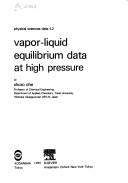Physical Sciences Data
3 total works
v. 43
Vapor-liquid equilibrium (VLE) data of solutions are necessary for the design of distillation and absorption processes. VLE exhibits various characteristics depending on the type of solution. In the case of nonideal solutions, an azeotropic mixture is formed which cannot be separated by ordinary distillation. The mixture must be separated by adding a third component, called an entrainer, which has the capability of breaking the azeotropic point. In most cases, a volatile component is employed as an entrainer for an azeotropic mixture. However, salt is also effective in breaking the point; this is called the salt effect on VLE. Much has been observed on salt effect, however very few commercial distillation plants use this method. This book aims to cover all reported data found in journals on salt effect on VLE. Prediction methods for VLE at low and high pressures for systems composed of volatile substances are used routinely, However, no method to predict the salt effect on VLE is in use, because salts show entirely different behavior from volatile substances. A method to predict salt effect based on preferential solvation was reported by the author in 1976.
30 systems were examined and the formation of preferential solvates between the salt and one of the volatile components was shown. Continuing the work, the formation of preferential solvates for almost all salt effect data has been examined. As a result of this work, it has been found that preferential solvates are formed without exception. In this volume, the preferential solvation numbers determined by least squares method are shown by processing the data of salt effect on VLE.
30 systems were examined and the formation of preferential solvates between the salt and one of the volatile components was shown. Continuing the work, the formation of preferential solvates for almost all salt effect data has been examined. As a result of this work, it has been found that preferential solvates are formed without exception. In this volume, the preferential solvation numbers determined by least squares method are shown by processing the data of salt effect on VLE.
High pressure vapor-liquid equilibrium data are important when very pure compounds are to be prepared, and they are also needed for high pressure liquid or supercritical chromatography. This volume is a compilation of high pressure vapor-liquid equilibrium data for 700 binary system, processed and plotted by computer for ready inspection of the whole spectrum. The information given for each system comprises: the components' names, chemical formulae, cited literature, and critical temperature, critical pressures, acentric factors of the components, optimized values of the parameters for the Peng-Robinson equations, the errors, and phase diagrams for visual comparison of the experimental data and calculated values. An alphabetical index by system name is included in the book which will be a useful reference for chemical engineers, research chemists, and graduate students who are interested in the chemical process industry.
Vapor-liquid equilibrium (VLE) data are necessary for the design and operation of distillation processes. It is absolutely impossible to determine a distillation process without VLE data. The author of this book has had much experience designing and constructing distillation processes and towers and knows that VLE data must be easily retrievable, readily comprehensible, and precise. This volume contains the most important VLE data for 1,446 binary systems with Wilson parameters determined by computer processing. The data are also presented graphically. The Wilson equation, which is known as one of the most applicable to multicomponent systems, is employed for computer-aided determination of the optimum parameters using the non-linear least squares method.

